Kanban project management software is essential for organizations looking to streamline their workflows, improve task visibility, and enhance productivity. These tools are perfect for teams that want to adopt a visual approach to managing their work, whether in development, marketing, or operations. In 2024, Kanban tools are advancing with innovative features tailored to different industries. This guide outlines the top 10 Kanban project management software solutions for various business needs, ensuring organizations can manage their tasks efficiently.
What is Kanban Board Software?
Kanban project management software is a visual project management tool that allows teams to manage tasks through a system of boards, lists, and cards. Its primary feature is the Kanban board itself, which consists of columns representing different stages of a task’s progress. Teams can move tasks (represented as cards) through stages like “To Do,” “In Progress,” and “Completed” to monitor progress visually. Key features include customizable workflows and real-time collaboration, enabling organizations to maintain an optimal flow of work.
These tools are widely used in Agile environments as they help teams continuously improve their processes by visually tracking task completion and identifying bottlenecks. Whether working on software development, marketing campaigns, or operational tasks, Kanban boards provide teams with clarity and flexibility. The software integrates with other project management tools, making it easier for organizations to staying online and track time, manage resources, and meet deadlines.
Benefits of Kanban Board Software
Kanban project management software offers numerous benefits, particularly for teams that need to improve transparency and task prioritization. The first key benefit is increased visibility into team workflows, allowing everyone to see the status of tasks at a glance, reducing the need for constant status meetings. This visual approach also promotes improved task prioritization, as team members can easily drag-and-drop tasks to indicate priority or reassign tasks quickly.
Additionally, Kanban boards help teams enhance agility, making it easier to adapt to changes and shift priorities as needed. This is especially helpful for Agile teams that need flexibility to accommodate project changes. Another significant advantage is reduced time to completion, as the software makes it easy to identify bottlenecks and areas of inefficiency within the project lifecycle.
Kanban tools also encourage better collaboration, as team members and stakeholders can work together in real-time, whether they are in the same office or working remotely. This leads to more effective communication and faster decision-making. For managers, these platforms provide performance tracking, making it easier to monitor productivity, reallocate resources, and ensure projects stay on track.
How to Choose the Right Kanban Board Software
Selecting the right kanban project management software depends on various factors, such as scalability, integration capabilities, and ease of use. Scalability is essential for growing teams and businesses, as the software must be able to accommodate more users, tasks, and projects without compromising performance. Additionally, it’s important to ensure the workplace offers customization options, allowing organizations to tailor workflows, boards, and task templates to suit their specific needs.
Another critical factor is the software’s integration capabilities. Teams should look for Kanban tools that can integrate with existing project management systems, CRMs, time-tracking software, and communication platforms like Slack or Microsoft Teams. This integration provides a seamless workflow across different applications, eliminating the need to switch between multiple tools.
User-friendliness is another key consideration, as a steep learning curve can slow down adoption and reduce the software’s effectiveness. The platform should offer an intuitive interface that’s easy for both tech-savvy and non-technical users to navigate.
Lastly, it’s important to consider pricing and support. Some platforms offer free versions with limited functionality, while others provide tiered pricing based on features and the number of users. Make sure to choose a solution that fits your budget and offers reliable customer support.
Best Kanban Board Software for 2024
Software Name | Key Features | Best For | Pricing per user/month |
Worksection | Task management, project management, time tracking, Gantt chart, Kanban, documents storage, calendar, reporting, real-time project tracking, access control | Small and medium-sized teams | From $3.4 per user/month |
Trello | Kanban boards, drag-and-drop functionality, basic task management | Small teams and freelancers | From $5 per user/month |
Asana | Task tracking, timelines, Kanban boards, real-time collaboration | Any type of big organizations | From $10.99 per user/month |
Monday.com | Customizable workflows, Kanban boards, task automation | Growing teams with complex workflows | From $9 per user/month |
ClickUp | Task automation, kanban boards, custom views, goal tracking | Teams needing flexibility and custom workflows | From $7 per user/month |
Wrike | Advanced Kanban boards, resource management, Gantt charts | Organizations managing complex projects | From $9.80 per user/month |
Basecamp | Task lists, file sharing, communication tools | Small teams needing simplicity | From $15 per user/month |
Zoho Projects | Task automation, time tracking, Kanban boards | Budget-conscious teams | From $4 per user/month |
Smartsheet | Grid-based interface, Gantt charts, kanban boards, real-time collaboration | Large organizations managing complex projects | From $9 per user/month |
Microsoft Project | Detailed scheduling, resource management, kanban boards, Gantt charts | Enterprise-level organizations | From $10 per user/month |
Worksection
Worksection is an all-in-one project management tool designed for small and mid-sized teams that need efficient, budget-friendly solutions. Combining task management, Gantt charts, time tracking and Kanban boards, Worksection helps teams manage multiple projects with ease. The Kanban boards allow teams to visualize workflows, adjust priorities, and seamlessly move tasks between phases. Time tracking ensures that project hours are well managed, while the Gantt chart helps plan and track project timelines. Integration with tools such as Google Drive enhances collaboration, enabling cross-team communication and document sharing.
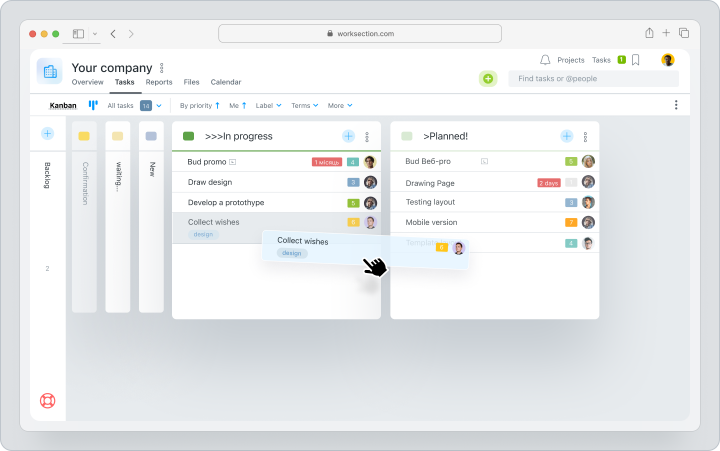
For teams on a budget, Worksection is especially attractive with pricing starting at just $3.4 per user per month. Learn more.
Trello
Trello is well-known for its easy-to-use, visual Kanban board system. Perfect for startups or smaller teams, Trello helps users track tasks, assign responsibilities, and monitor deadlines. The drag-and-drop interface is intuitive, requiring minimal training for teams to adopt. Teams can easily integrate Trello with other apps like Slack, Google Drive, and more.

Pricing starting at $5 per user/month, Trello offers an accessible and highly customizable project management solution for businesses focused on visual task tracking. Learn more.
Asana
Asana offers powerful project management features, making it ideal for businesses of all sizes. With tools like task tracking, timeline visualization, and workflow automation, Asana helps teams manage everything from day-to-day operations to large projects. Teams benefit from seamless integrations with tools like Slack, Google Drive, and Zoom, ensuring streamlined communication and file sharing. With its intuitive design and robust feature set, Asana is perfect for managing complex workflows.
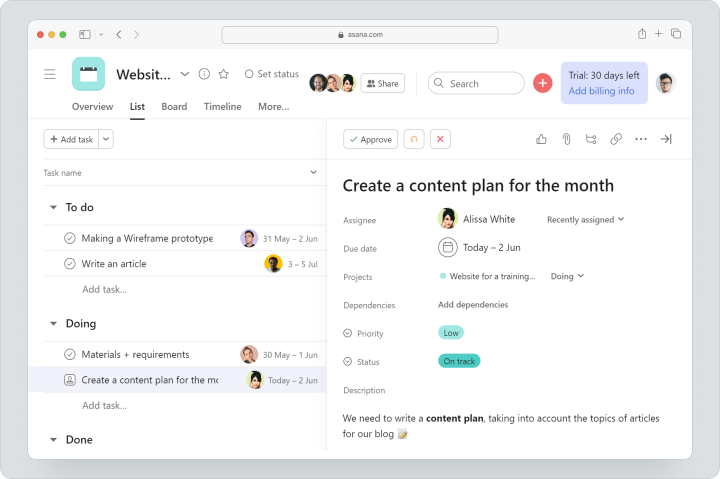
Pricing starts at $10.99 per user/month, making it an excellent choice for teams that need an organized, flexible project management solution. Learn more.
Monday.com
Monday.com is designed for teams that require flexible project management solutions. With features like customizable workflows, time tracking, and automation tools, Monday.com allows teams to manage projects efficiently. Its visual interface offers a simple way to keep track of progress and deadlines. Additionally, it integrates with many popular apps like Slack and Google Calendar, creating a smooth workflow.
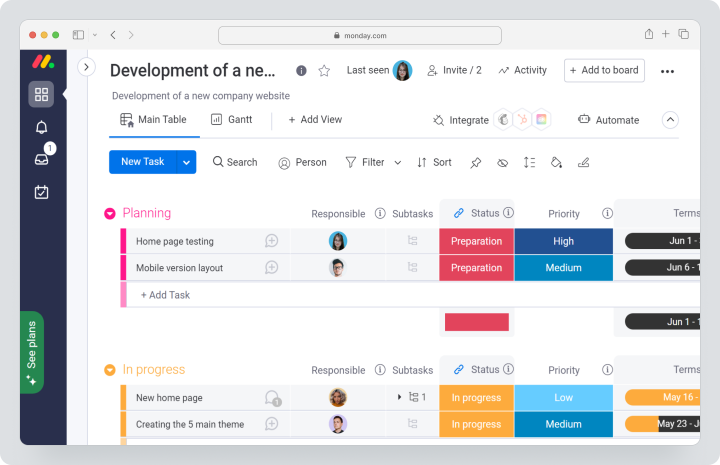
With pricing starting at $9 per user/month, Monday.com is a scalable solution for businesses looking to manage their projects and collaborate effectively. Learn more.
ClickUp
ClickUp offers a comprehensive project management solution, making it perfect for teams with diverse needs. ClickUp’s features include task automation, custom views, goal tracking, and workload management. This platform supports multiple project views like lists, boards, and calendars, allowing teams to manage tasks in a way that best suits their workflow. ClickUp integrates with popular tools like Slack and Google Workspace, making it a versatile and powerful project management tool.
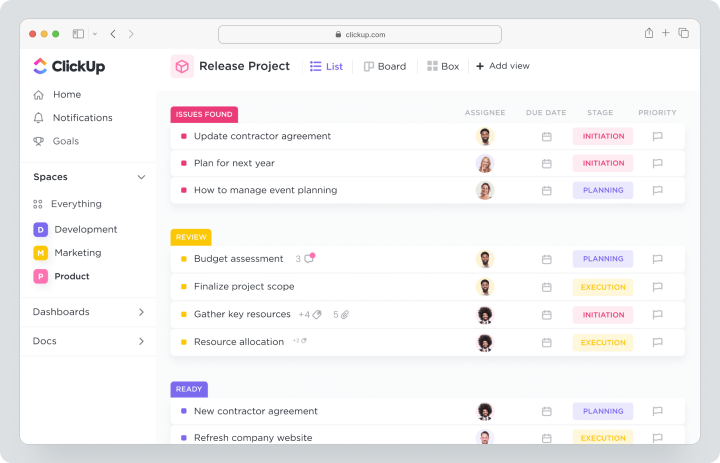
Starting at $7 per user/month, ClickUp is a flexible, budget-friendly solution for teams needing customizability and powerful project management features. Learn more.
Wrike
Wrike is an advanced project management application, ideal for teams managing multi-layered projects. Its features include Gantt charts, resource management, and real-time collaboration tools, providing everything a team needs to stay organized and efficient. Wrike also offers robust reporting tools, which allow teams to analyze project data and optimize workflows. Integrating with popular platforms like Google Drive and Salesforce, Wrike ensures that all team members stay aligned.
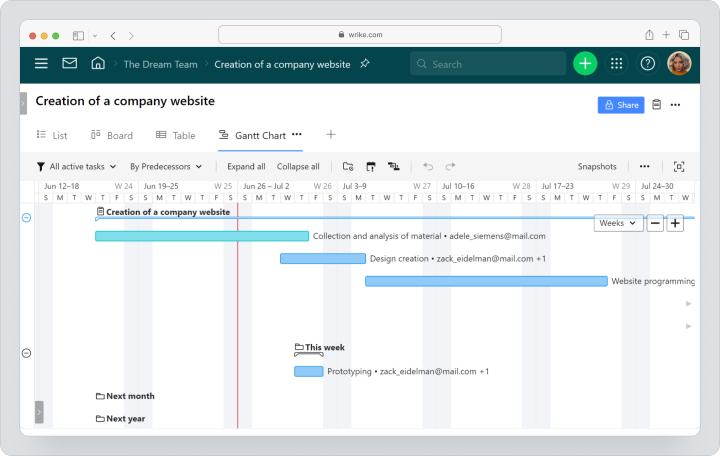
Pricing starts at $9.80 per user/month, making it suitable for teams looking for advanced project management solutions. Learn more.
Basecamp
Basecamp is renowned for its simplicity, offering an easy-to-use project management solution for smaller teams that don’t need overly complex features. Basecamp allows users to manage tasks, share files, and communicate with team members all in one place. It’s an excellent choice for teams looking for a straightforward way to manage daily operations, from donor outreach to event planning.
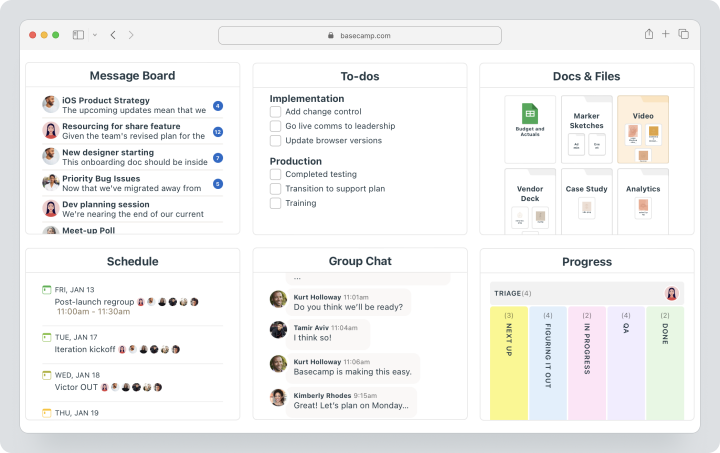
With pricing starting at $15 per user/month, Basecamp is an efficient solution for teams wanting simplicity and ease of use in their project management tool. Learn more.
Smartsheet
Smartsheet combines a familiar grid-based interface with powerful project management features, making it perfect for teams managing complex projects. Smartsheet helps teams track resources, deadlines, and tasks with ease. With seamless integrations to tools like Microsoft Office and Google Workspace, Smartsheet ensures smooth collaboration and efficient workflows.
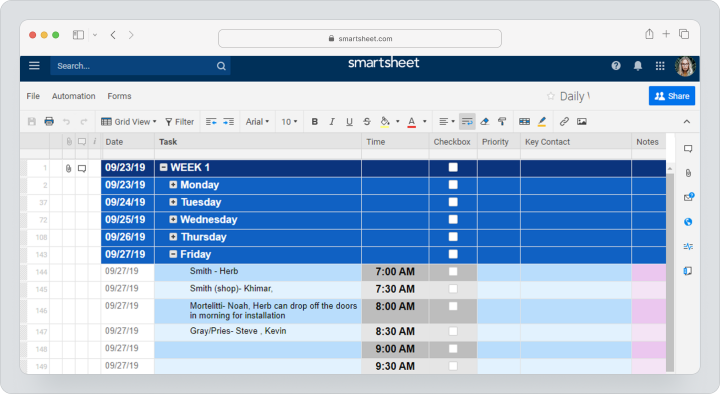
The platform’s automation features further enhance productivity, making it a top choice for teams with multi-layered projects. Pricing starts at $9 per user/month. Learn more.
Zoho Projects
Zoho Projects is a cost-effective project management tool that offers comprehensive features like task automation, time tracking, and seamless integrations with Zoho’s suite of business tools. Teams can use Zoho Projects to manage tasks, allocate resources, and keep track of project timelines, ensuring efficient operations. With integrations available for other business apps like Slack and Dropbox, Zoho Projects helps teams stay connected and organized.
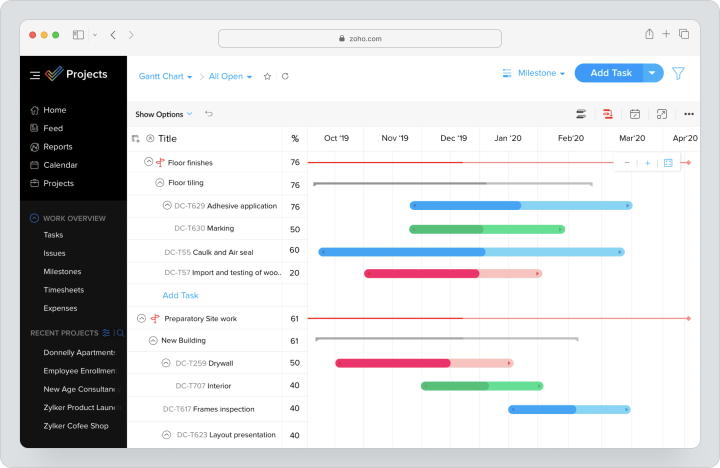
Pricing starts at $4 per user/month, making it a great solution for teams that need a budget-friendly yet powerful project management tool. Learn more.
Microsoft Project
Microsoft Project is an ideal solution for teams that require advanced scheduling and resource management. It integrates seamlessly with the Office 365 suite, allowing users to easily incorporate Microsoft tools into their project management workflows. Microsoft Project’s robust scheduling, task tracking, and Gantt charts help teams keep complex projects organized. It’s particularly well-suited for teams already familiar with Microsoft products.
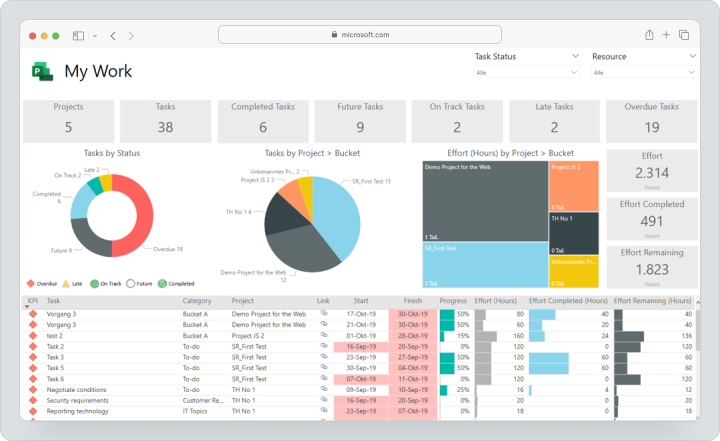
Pricing starts at $10 per user/month, making it a comprehensive solution for managing large-scale projects. Learn more.
Who Should Use Kanban Board Software?
Kanban project management software is suitable for a variety of teams and industries, including:
- Software Development Teams: Agile developers can track user stories, bug reports, and feature updates using Kanban boards, ensuring tasks move efficiently from planning to release.
- Marketing Agencies: With campaigns often involving multiple moving parts, Kanban boards allow marketing teams to track deliverables, deadlines, and client feedback in a structured and visual way.
- Operations Management: For operational teams, Kanban boards offer a clear view of ongoing tasks and the ability to adjust priorities as new tasks emerge.
- Creative Teams: Designers and content creators can use Kanban tools to visualize their project pipelines, allocate resources, and collaborate on creative briefs.
Integrating Kanban Board Software with Other Tools
Kanban project management software can integrate seamlessly with CRM systems, communication tools, and other project management software, boosting productivity and simplifying project execution. By integrating with CRM systems, Kanban boards help track leads and manage customer interactions visually. For instance, teams can use Kanban boards to track the progress of client onboarding, moving leads through various stages while keeping all customer data centralized. This integration allows the sales and marketing teams to stay aligned, improving follow-ups and customer satisfaction by having real-time access to important CRM data directly on the board.
Integrating communication tools like Slack or Microsoft Teams with Kanban boards enhances team collaboration. With these integrations, team members receive real-time updates and notifications about task progress or changes, eliminating the need for constant email updates. For example, when a task is moved to a different column, an automatic message can be triggered in Slack, ensuring everyone stays informed without leaving their workspace. This boosts decision-making efficiency and ensures that team members are always up-to-date.
When Kanban boards are integrated with other project management tools, such as Gantt charts or resource management tools, it allows for cross-platform visibility. This integration ensures that teams using different methods can still collaborate effectively. For example, integrating with timeline tools ensures that tasks on the Kanban board reflect deadlines accurately, enhancing overall workflow and resource management.
Trends in Kanban Board Technology
Kanban project management software technology is constantly evolving to meet the growing needs of modern teams. One of the latest trends is the integration of predictive analytics, which allows teams to forecast potential project bottlenecks and delays based on past performance data. This capability helps teams proactively address issues before they impact project timelines.
Another emerging trend is the use of task automation, which eliminates repetitive tasks like updating deadlines or moving tasks through different stages of completion. This frees up teams to focus on more critical aspects of their work while ensuring that no tasks fall through the cracks.
The rise of mobile app functionality is also making it easier for teams to manage their Kanban boards on the go. With enhanced mobile apps, team members can access real-time updates, move tasks, and collaborate with their teammates, regardless of their location.
Improved customization options are also becoming more popular, allowing teams to create bespoke workflows, adjust WIP limits, and set specific rules for task automation. These advancements are helping teams across industries streamline their workflows, improve task management, and increase overall project efficiency.
FAQ
How does Kanban board software facilitate remote teamwork?
Kanban project management software supports remote teams through features like real-time updates, cloud-based access, and built-in communication tools, making it easy for distributed teams to collaborate and stay aligned on project goals.
What are the typical costs involved with adopting Kanban board software?
Kanban project management software varies in price, with free versions available for smaller teams and paid plan options starting at $3.4 to $15 per user/month for advanced features. That means you can find a cost effective solution with good value for money.